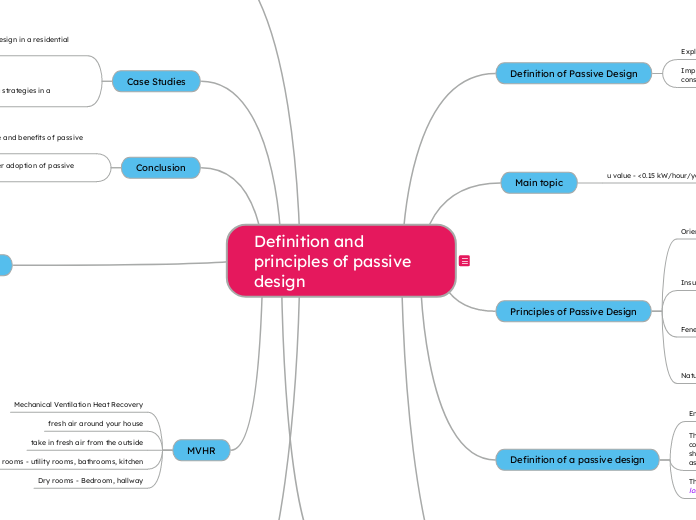Definition and principles of passive design
Definition of Passive Design
Explanation of passive design
Importance of passive design in building construction
Main topic
u value - <0.15 kW/hour/year
Principles of Passive Design
Orientation and layout
Maximizing solar gain
Minimizing solar heat gain
Utilizing natural ventilation
Insulation and thermal mass
Importance of insulation
Utilizing thermal mass for temperature regulation
Fenestration and shading
Proper window placement for daylighting
Use of shading devices to prevent unwanted heat gain
Natural ventilation
Strategies for promoting airflow
Incorporating stack effect and cross ventilation
Definition of a passive design
Energy efficient house
The idea of a passive house is to maximize comfort in the house. Natural light/resources should also be taken into consideration and used as much as possible in the house.
The concept of a passive house is to minimize heat loss and maximize heat gain.
Keywords
Benefits of Passive Design
Energy efficiency
Reducing reliance on mechanical heating and cooling systems
Lowering energy consumption and utility bills
Comfort and well-being
Providing optimal indoor thermal and visual comfort
Enhancing occupant health and productivity
Environmental sustainability
Minimizing greenhouse gas emissions
Preserving natural resources
Case Studies
Example 1: Passive solar design in a residential building
Description of the building's passive design features
Analysis of energy savings and user satisfaction
Example 2: Passive cooling strategies in a commercial building
Overview of the building's passive cooling techniques
Evaluation of indoor comfort and energy efficiency
Conclusion
Recap of the importance and benefits of passive design
Encouragement for wider adoption of passive design principles
Key Principles of passive design
Compact form
Solar Gain
Thermal mass
Preventing thermal bridging
Super insulation
Airtightness
MHVR
MVHR
Mechanical Ventilation Heat Recovery
fresh air around your house
take in fresh air from the outside
wet rooms - utility rooms, bathrooms, kitchen
Dry rooms - Bedroom, hallway
Heat exchange
Fresh air from the outside turns into warm air on the inside
Outside cold air goes into the heat exchanger and this will leave a warm supply of fresh air inside the house
